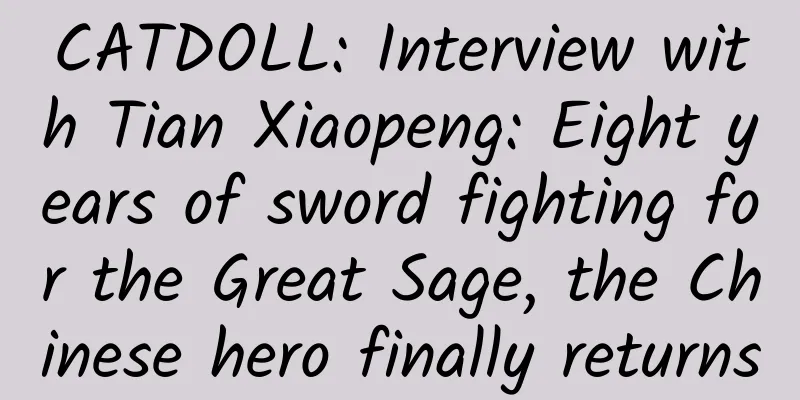CATDOLL: Interview with Tian Xiaopeng: Eight years of sword fighting for the Great Sage, the Chinese hero finally returns

|
When the monkey with red eyes and golden pupils and an axe-like face melted stones into armor, waved flames into robes, and walked over the stones with the golden hoop on his shoulder, the children in front of the giant screen could not help but shout: "Great Sage! Great Sage! He is so handsome!" Director Tian Xiaopeng sat in the audience, quietly enjoying the moment. The 3D animated film "Journey to the West: Hero is Back" is the result of his eight years of hard work, in order to give his son a real Chinese superhero. The film was released on July 10. Previously, the film had set the highest overseas sales record for Chinese animated films in Cannes. It is also the only animated film shortlisted for the Shanghai Film Festival Media Awards in its 12-year history.
In addition to Sun Wukong, the movie also features the Azure Dragon riding the wind, the dreamy and gorgeous Zhongnan Mountain, the enchanting Hanging Temple, the giant stone human-faced God of the Five Elements... Such distinctive and rich oriental elements not only did not make Western audiences feel uncomfortable, but instead made them intoxicated by it. "The film tells the story of regaining dreams with love and courage, which is the core that audiences all over the world can understand," said the 40-year-old director. "I completed this story by standing on the shoulders of giants." This giant is the world-renowned fantasy novel "Journey to the West". The story of the monk Tang and his three disciples going to the West to seek Buddhist scriptures has been interpreted in countless classics, such as "Havoc in Heaven" produced by Shanghai Fine Arts Film Studio in 1964 and the TV version of "Journey to the West" in the 1980s. Among them, the Monkey King Sun Wukong played by Liu Xiaolingtong is a household name on the screen. Eight Years of Sword As a 3D kung fu animation film full of oriental elements, "The Monkey King: Hero is Back" is inevitably compared with Hollywood's "Kung Fu Panda". Tian Xiaopeng believes that there may be references to the scenes, but the two protagonists are completely different cultural products, and their temperaments and life stories are completely different.
The pre-production team drew dozens of versions of the Monkey King - from the dark and wild chimpanzee at the beginning, to the demonic and exaggerated gibbon, and finally to the long-faced uncle, all of them were "not beautiful" without exception. Tian Xiaopeng wants an Eastern-style hero: unruly, experienced, tragic, but never yielding and never giving up his dreams. To match the protagonist's character development, the film design team designed three sets of costumes for the Monkey King: one set is used when he makes trouble in Heaven, which is exaggerated and gorgeous but not particularly clear, reflecting the Monkey King in people's imagination; one set is used when he breaks free from the shackles, emphasizing the helplessness and weakness of the hero at the end of his life; one set is used when the hero returns, which is clear and powerful, with distinct patterns, representing the sublimation of self. In fact, many details in the movie reveal the ultimate of "eight years of hard work": the fluttering red cape, the little crescents on the nails, the growing hair, the changing beards of passers-by... During the "dynamic storyboard" stage, Tian Xiaopeng asked the technical team "not to consider time and cost, but to achieve ultimate perfection." This directly led to a three to four-fold increase in the cost of this stage, which lasted more than two years. In the movie, an oriental dragon that flies on the wind and lives on water allows the audience to see the "complete" appearance of a dragon for the first time in a domestic 3D movie.
Why is it difficult to make a 3D dragon? Tian Xiaopeng said that firstly, the Chinese dragon only lives in imagination. The description of it in the Classic of Mountains and Seas is "a beast on it, shaped like an ox, and there will be wind and rain when it enters and leaves the water, its light is like the sun and the moon, and its sound is like thunder," but it lacks details; secondly, it is difficult to present the technology. The dragon is long and boneless, and it takes dozens of controllers to make it "soar", "roll" and "swim" at the same time. In order to save costs, many domestic films let the dragon "be lazy" by relying on clouds, water and other obstructions. In order to break the superstition and worship of Western CG (Computer Graphics) technology, Tian Xiaopeng and his team drew on classics such as the Nine Dragon Wall and the Dragon Totem of the Western Han Dynasty, experimented with many technical solutions, and finally created a complete dragon that conforms to oriental aesthetics. "There is indeed a gap between China's CG technology and that of the West, but we can find our own way to achieve the same effect," said Tian Xiaopeng. Share this body Eight years ago, Tian Xiaopeng chose Sun Wukong as the breakthrough point for the story, because this story involves kung fu and magic, and is best presented with CG; eight years later, he discovered that he and the Monkey King had long been inseparable and shared one body, and that the monkey was the same as him - in order to exalt, one must first suppress. In 1995, when Tian Xiaopeng was a junior majoring in software at Beijing University of Technology, a friend copied him a copy of 3D software on a 3-inch disk. From then on, he deleted all the games on his computer and devoted himself to studying 3D. "3D is so interesting, I know this is what I want to do for the rest of my life." After graduating from university, Tian Xiaopeng went to work for a foreign animation design company. In 1997, Tian Xiaopeng's company received the production of some episodes of the domestic animation "Journey to the West". This was his first encounter with Journey to the West, but at that time, this animation for young children did not move him much.
"I was ambitious and wanted to do everything, but I didn't know what I really wanted to do." Tian Xiaopeng commented on his young self. In the past ten years, he gradually made a name for himself in the Chinese CG animation industry, and created some well-known works in the industry. He directed the promotional video for the American Spider-Man game and did animation outsourcing for Hollywood, but he felt that "there was no way out." "The market is flooded with Japanese and American animations, while domestic animations are childish and poorly made, and audiences regard original Chinese animations as a laughing stock," said Tian Xiaopeng. People were leaving the company every day, and some good friends who had worked with him along the way switched to animation training and made a lot of money. This made Tian Xiaopeng, who was staying in the studio, feel unprecedented "loneliness and despair". One day eight years ago, Tian Xiaopeng saw his two-year-old son watching Ultraman and Batman with great interest, and his heart was completely broken. "I have to do something, at least let my son watch his father's works when he is old enough to watch cartoons." At the Beijing premiere on July 6, his 10-year-old son watched the film with his classmates. "I didn't ask him what he thought, but I think he was very proud of it." Tian Xiaopeng's tone was no longer that of a director, but rather that of a father. Hold this thought "The Monkey King: Hero is Back" became popular before it was released. Netizens made their own posters and videos, and spontaneously promoted the film, which became a unique phenomenon. Many of them were born in the 1990s who grew up reading foreign comics, which touched Tian Xiaopeng very much.
In recent years, there have almost always been different voices in Tian Xiaopeng's team, but he has insisted on one idea - "Don't make it for young children, but make a big movie for all ages." The villain in the film is taken from "Hundun" in "Classic of Mountains and Seas". In the book, it is a singing bird, but in the film, it turns into an ugly giant insect that devours everything. In order to obtain a flesh body, it preys on boys and girls, but still only has the skin of a "faceless scholar". Tian Xiaopeng gave up the classic villains in the original novel, such as Bull Demon King, King of Gold and Silver Horns, and Red Boy, because he saw the intangible nature of "chaos". "The monsters in Journey to the West are too concrete, too much like human behavior. 'Chaos' represents an invisible fear, symbolizing the demon lurking in the heart of Sun Wukong."
"I have always liked things of a large scale, and I believe that children's ability to understand is not as simple as adults imagine." Tian Xiaopeng said. When he was a teenager, a cartoon called "Robotech" overturned his worldview - it turned out that cartoons could explore peace and love so deeply. Of course, some audiences and film critics criticized the "thin script." Tian Xiaopeng said that he accepted all the criticisms because eight years ago he was indeed "more experimental" and did not expect to be able to get to where he is today. "I don't like to use too many dialogues and scenes to tell the story thoroughly. For example, why Bailong came back may require one picture or a few shots to explain it clearly, but I deliberately left it blank. This may be my personal style." Tian Xiaopeng explained. Currently, the framework of the second part of "The Monkey King" has been set up and the script is being written. "Perhaps, the King of Gold and Silver Horn will appear in the later movies." The confident director posted nine self-made movie posters on WeChat Moments. He wrote: I always wanted to live a spectacular life, but I never had the chance. Today is the day! Original post address: Click to enter |
>>: CATDOLL: Naruto official website mysterious countdown revealed: "Boruto" release eve festival
Recommend
CATDOLL: "Food Wars! Soma" manga chapter 182 preview image: Blackened chefs fight
The preview image of the 182nd chapter of the man...
CATDOLL: Introduction to the new series "Yowamushi Pedal GRANDE ROAD" in October 2014
The decision to produce the second season of the ...
CATDOLL: Anime Starry Sky Evening News: Dragon Ball Super Episode 49 trailer: Netizens hotly discuss the most handsome transformation in JUMP history
Good evening, everyone. Dragon Ball Super episode...
CATDOLL: What happened to the promised restoration of the main actors in the live-action version of "The Genius of Mahjong"?
This morning, the live-action version of "Ge...
CATDOLL: "Saint Seiya Saint Girls Sho" major announcement may be animated
The Japanese manga "Saint Seiya: Saint Girls...
CATDOLL: "Sword Art Online" Kirito promoted to Internet Security Ambassador Black Swordsman is invincible
Starting from February 1, 2017, Japan's Natio...
CATDOLL: The third season of "Restaurant Dinner" will be broadcast as a 1-hour special
The first episode of the new October anime "...
CATDOLL: The 42nd chapter of the comic "Brave Adventure" opens the Thunder God's coming
The 42nd chapter of the comic "Brave Adventu...
CATDOLL: A photo of Taichi and Agumon appears in the copyrighted painting of "Digimon Adventure tri."
As the most important part of the 15th anniversar...
CATDOLL: The Q version of "Boruto" will reach its climax next month with the serialization of "Uchiha Sasuke's Sharingan Legend"
The Q version of Boruto will be serialized in the...
CATDOLL: Details of the autumn broadcast of the rugby animation "ALL OUT!!" have been released
The TV animation "ALL OUT!!", adapted f...
CATDOLL: Theme song and ending song of "Beautiful High School Earth Defense Club LOVE Season 2" have been confirmed
The theme song and ending song of the second seas...
CATDOLL: "Ordinary High School Girl Wants to Become a Local Idol" New OVA Production Decision
The TV animation "Ordinary High School Girls...
CATDOLL: The third part of the movie "Kizumonogatari" "Cold Blooded" will be released in January 2017
The second part of the Kizumonogatari theatrical ...
CATDOLL: Are there any young comics that don’t rely on their fathers? One Punch Man disagrees
Nowadays, Japanese hot-blooded youth comics seem ...









